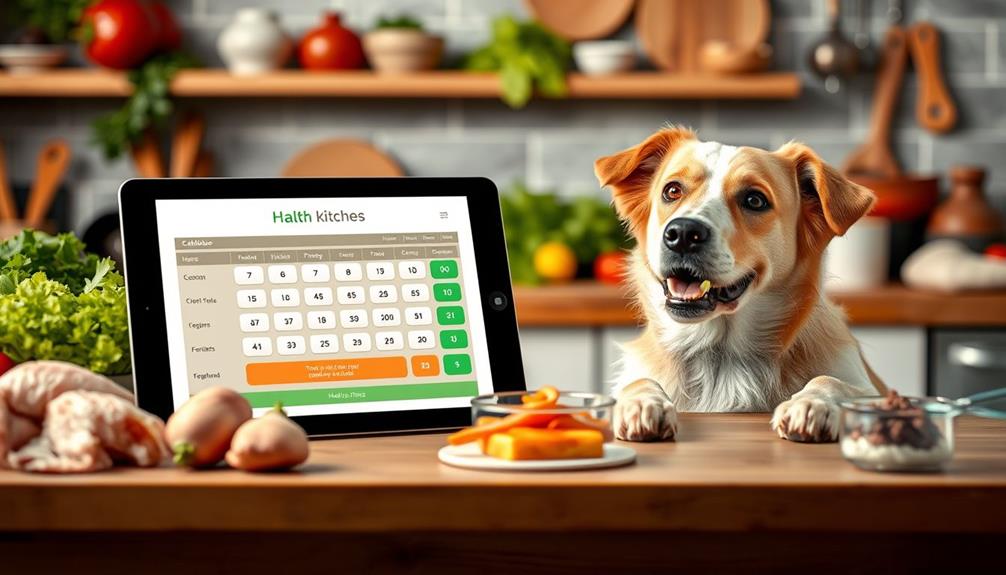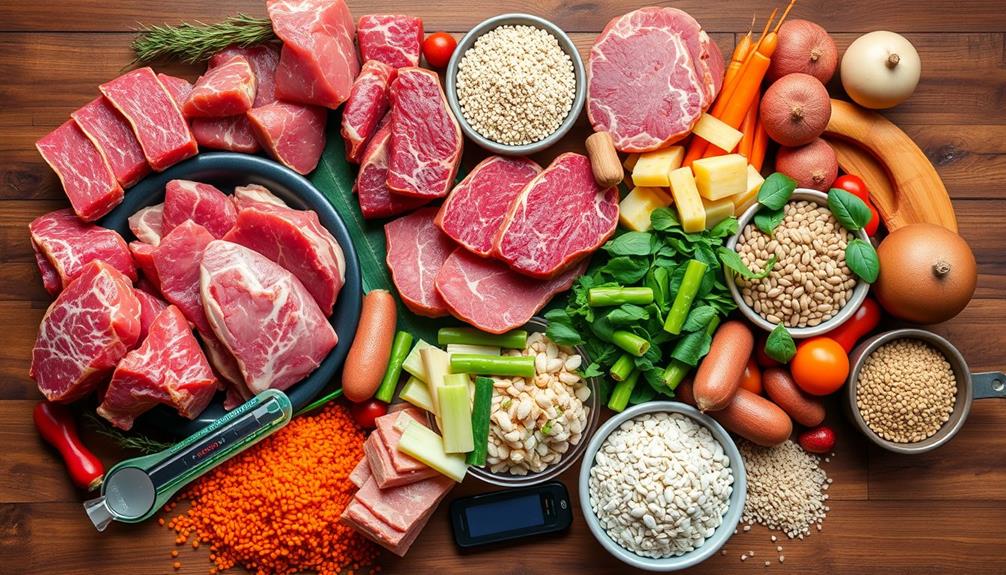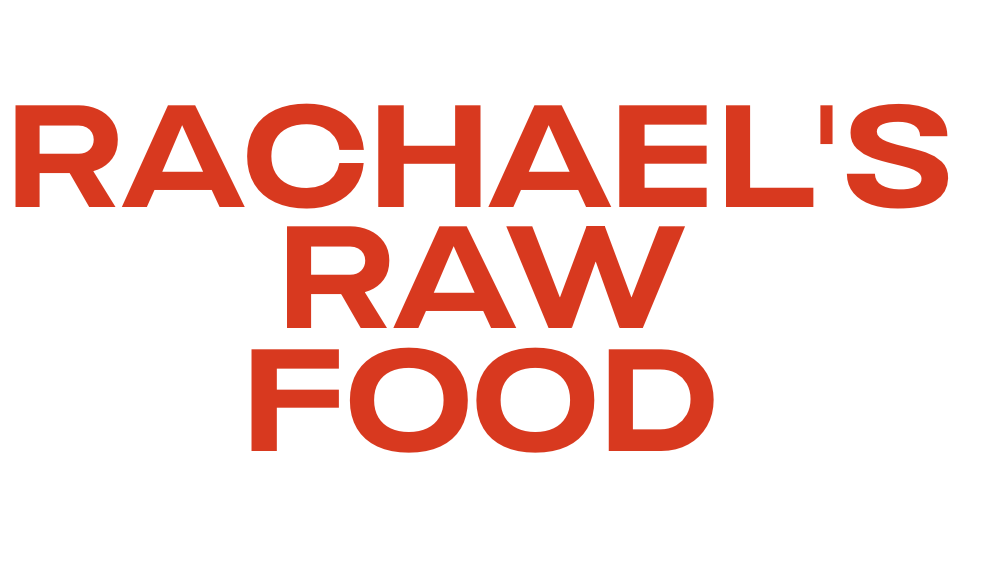To find out how much raw food to feed your dog, you'll want to use a dog food calculator. Generally, adult dogs need about 2% to 3% of their ideal body weight in raw food daily. For example, if your dog weighs 30kg, feed them between 600g and 900g of raw food each day. Puppies, on the other hand, require 5% to 10% of their body weight until six months old. Be sure to monitor their weight and adjust accordingly. If you want to know more about specific feeding guidelines and nutrients, keep exploring!
Key Takeaways
- Enter your dog's weight into the calculator to determine daily raw food needs based on their ideal body weight.
- Choose between 2% to 3% of your dog's body weight for adult dogs, or 5% to 10% for puppies.
- The calculator breaks down daily intake into muscle meat (80%), edible bones (10%), and organ meats (10%).
- Consider your dog's activity level, age, breed, and health conditions when adjusting food intake.
- Regularly monitor your dog's weight and adjust food portions as needed for optimal health.
Raw Food Feeding Guidelines
When determining how much raw food to feed your dog, it's vital to take into account their weight and life stage. Dogs thrive on a balanced diet, and understanding their nutritional needs is important for their overall health.
For adult dogs, the recommended food intake is typically 2% to 3% of their ideal body weight daily. For example, if your dog weighs 30kg, you should aim to provide around 600g to 900g of raw food each day. Additionally, providing a variety of proteins and nutrients can enhance their well-being, so consider incorporating safe snacks for pets like safe snacks for hamsters into their diet.
Puppies, on the other hand, require more raw feeding, needing about 5% to 10% of their body weight until they reach six months, at which point their intake can decrease to around 5%. Regularly monitoring your dog's weight is vital, as you'll need to adjust the amount of raw food based on any changes to help maintain their health.
For ideal feeding, consider dividing their daily portion into two meals. Keep in mind that smaller dogs often need a higher percentage of their body weight in food compared to larger breeds.
Utilizing a raw dog food calculator can assist you in determining the specific amount of raw food based on your dog's weight, activity level, and dietary preferences, ensuring they're getting tailored nutrition. Calculating raw food for dogs can be a bit overwhelming with varying opinions on what is best for your pet. However, using a raw dog food calculator takes the guesswork out of the equation and provides you with a precise feeding plan. Instead of relying on generic guidelines, you can feel confident that you are providing your dog with the right balance of nutrients for their individual needs.
Using the Dog Food Calculator

A dog food calculator is an excellent tool for tailoring your pet's raw food diet to their specific needs. To get started, you'll need to input your dog's weight, as this is vital for determining the amount of food needed. By selecting the percentage of their diet that consists of raw food—from 10% to 100%—you can calculate the appropriate daily intake for your dog. Incorporating healthy dog snacks can also enhance your pet's overall diet and guarantee they stay satisfied.
The calculator will break down the daily food intake into components like muscle meat (80%), edible bones (10%), and organ meats (10%). This guarantees a balanced diet tailored to your dog's nutritional requirements.
Don't forget to take into account your adult dog's activity level, as this can influence their dietary needs. Higher activity may mean they require more food, while less active dogs might need less.
Adjustments to food intake may also be necessary based on individual factors such as age, breed, and overall health. Using the dog food calculator provides a guideline to guarantee your dog gets the right balance of nutrients, helping you monitor their health and adjust their raw food intake as needed.
Puppy Feeding Requirements

Feeding your puppy the right amount of raw food is essential for their growth and development. Puppies generally need about 5-10% of their body weight in raw food daily. As they grow, you'll notice the ideal body weight changes; by around six months, this amount decreases to about 5%.
To guarantee they thrive, very young puppies should be fed 3-4 times a day, while older puppies do well with twice-daily feedings. Proper nutrition during these critical development stages is vital, as it influences their overall health and well-being, much like the importance of key domains of development.
It's vital to monitor your puppy's growth closely. Adjust the food to feed based on their body weight per feeding to support healthy development. A puppy food calculator can be incredibly helpful in determining the appropriate daily feed volume based on your puppy's weight and age.
Transitioning to Raw Diet

As your puppy matures and you consider changing their diet to raw food, it's important to approach this alteration thoughtfully. Shifting to a raw diet requires careful planning to guarantee your dog's health and comfort.
Start by introducing small portions of raw food per meal, gradually increasing over the first week. This slow change can help minimize digestive issues, similar to how juice diets may lead to gastrointestinal discomfort in humans.
During this initial phase, you might notice some weight loss in your dog, primarily due to water weight. This is normal, so don't panic.
However, keep an eye on their weight; the recommended loss shouldn't exceed 1-2% of your dog's body weight per week. This guarantees that your pet remains healthy throughout the shift.
Consulting with a veterinarian is essential during this period. They can provide personalized advice tailored to your dog's specific needs and monitor their health.
Pay close attention to how your dog responds to the new diet, as this will help you make necessary adjustments to guarantee nutritional adequacy.
With patience and care, your adult dog can thrive on a raw diet, enjoying the benefits of pets raw.
Nutritional Considerations for Dogs

Understanding your dog's nutritional needs is vital when changing to a raw diet. Dogs thrive on a balanced diet consisting of muscle meat (58-80%), edible bones (10-17%), and organ meats (5-7%).
For adult dogs, you should aim to provide 2-3% of their ideal body weight in raw food daily. Puppies, due to their rapid growth, may need 5-10% depending on their puppy age. It's important to consult with a veterinarian to guarantee that the raw diet meets all necessary financial considerations for elderly care aspects, particularly if you have budget constraints.
Essential nutrients like ALA, EPA + DHA, iodine, manganese, and vitamin D are vital for maintaining your dog's health. Regularly monitoring your dog's body composition allows you to adjust their food intake and guarantee they get the nutrition they need, supporting an active lifestyle.
Be cautious, as nutritional deficiencies can occur when feeding raw diets like PMR and BARF. To mitigate this risk, consider incorporating supplements tailored to your dog's specific dietary needs.
Including a Meaty Bone in their diet can also help provide necessary minerals and support dental health. By paying close attention to these factors, you can successfully shift your dog to a raw food diet that promotes their overall well-being.
Frequently Asked Questions
How Much Raw Food Should I Feed My Dog Chart?
To determine how much raw food to feed your dog, refer to a feeding chart based on their weight and age. Adjust amounts regularly to maintain a healthy weight and meet their dietary needs.
What Is the 80 10 10 Rule for Raw Dog Food?
Imagine a well-balanced meal for your dog. The 80/10/10 rule suggests you feed them 80% muscle meat, 10% edible bone, and 10% organ meat to guarantee they get essential nutrients for peak health.
How to Calculate Homemade Dog Food Portions?
To calculate homemade dog food portions, consider your dog's weight and activity level. Generally, aim for 2-3% of their body weight daily, adjusting as needed to maintain a healthy weight and meet nutritional needs.
What Are the Proportions for Raw Dog Food?
The ideal raw dog food proportions are 58-80% muscle meat, 10-17% edible bone, 5-7% liver and organs, plus about 7% vegetables. Tailor these based on your dog's weight and health needs for balanced nutrition.
Conclusion
Switching your dog to a raw food diet can seem intimidating, but with the right guidelines, you'll be on the right track in no time. By using the dog food calculator and considering your pup's specific needs, you can guarantee they're getting the nutrition they deserve. Remember, a happy dog is a healthy dog, and making this change could be the key to releasing their full potential. Don't wait—take the plunge today!










